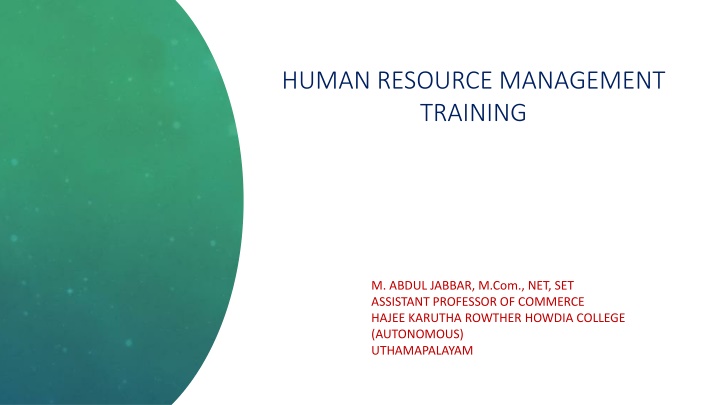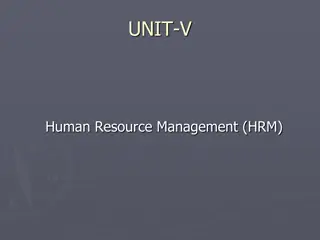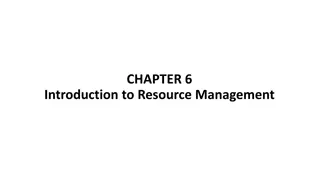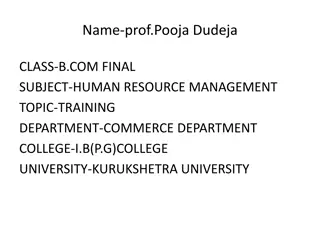Importance of Training and Development in Human Resource Management
Training is defined as the act of enhancing employee knowledge and skills for specific job roles. Human Resource Management focuses on planning, acquiring, training, and developing individuals to achieve organizational objectives. Training is crucial for organizational success, enhancing employee performance, addressing shortcomings, and increasing productivity. Employee satisfaction and improved performance are outcomes of effective training programs.
Download Presentation

Please find below an Image/Link to download the presentation.
The content on the website is provided AS IS for your information and personal use only. It may not be sold, licensed, or shared on other websites without obtaining consent from the author.If you encounter any issues during the download, it is possible that the publisher has removed the file from their server.
You are allowed to download the files provided on this website for personal or commercial use, subject to the condition that they are used lawfully. All files are the property of their respective owners.
The content on the website is provided AS IS for your information and personal use only. It may not be sold, licensed, or shared on other websites without obtaining consent from the author.
E N D
Presentation Transcript
HUMAN RESOURCE MANAGEMENT TRAINING M. ABDUL JABBAR, M.Com., NET, SET ASSISTANT PROFESSOR OF COMMERCE HAJEE KARUTHA ROWTHER HOWDIA COLLEGE (AUTONOMOUS) UTHAMAPALAYAM
According to Edwin B. Flippo, Training is the act of increasing the knowledge and skill of an employee for doing a particular job DEFINITION AND DEFINITION AND MEANING OF MEANING OF TRAINING TRAINING Human Resource Management is concerned with the planning, acquisition, training & developing human beings for getting the desired objectives & goals set by the organization. The employees have to be transformed according to the organizations' & global needs. This is done through an organized activity called Training. Training is a process of learning a sequence of programmed behaviour. It is the application of knowledge & gives people an awareness of rules & procedures to guide their behaviour. It helps in bringing about positive change in the knowledge, skills & attitudes of employees. Thus, training is a process that tries to improve skills or add to the existing level of knowledge so that the employee is better equipped to do his present job or to mould him to be fit for a higher job involving higher responsibilities. It bridges the gap between what the employee has & what the job demands.
NEED FOR TRAINING NEED FOR TRAINING Training is crucial for organizational development and success. It is fruitful to both employers and employees of an organization. An employee will become more efficient and productive if he is trained well. I. New Hire Orientation: Training is particularly important for new employees. This can be conducted by someone within the company and should serve as a platform to get new employees up to speed with the processes of the company and address any skill gaps. II. Tackle shortcomings: Every individual has some shortcomings and training and development helps employees iron them out. For example divide the entire headcount in several groups to provide focused training which is relevant to those groups - sales training, first time managers, middle management, senior leadership, executive leadership.
III. Improvement in performance: If shortcomings and weaknesses are addressed, it is obvious that an employee's performance improves. Training and development, however, also goes on to amplify your strengths and acquire new skill sets. It is important for a company to break down the training and development needs to target relevant individuals. IV. Employee satisfaction: A company that invests in training and development generally tends to have satisfied employees. However, the exercise has to be relevant to the employees and one from which they can learn and take back something. It will be futile if training and development become tedious and dull, and employees attend it merely because they have to. As a company, we should stress on industry specific training and send many employees for international seminars and conferences that can be beneficial to them.
V. Increased productivity: In a rapidly evolving landscape, productivity is not only dependent on employees, but also on the technology they use. Training and development goes a long way in getting employees up to date with new technology, use existing ones better and then discard the outdated ones. This goes a long way in getting things done efficiently and in the most productive way. VI. Self-driven: Employees who have attended the right trainings need lesser supervision and guidance. Training develops necessary skill sets in employees and enables them to address tasks independently. This also allows supervisors and management to focus on more pressing areas.
OBJECTIVES OF TRAINING PROGRAMME OBJECTIVES OF TRAINING PROGRAMME To impart to new entrant s basic knowledge and skills, To assist the employees to function more effectively in their present position by exposing them to the latest concepts, information and techniques and developing in them the skills required in their fields, To build up a second line of competent officers and prepare them as a part of their career progression to occupy more responsible positions. To broaden the minds of the senior managers by providing them opportunities for interchange of experiences within and outside with a view to correct the narrow outlook that may arise from over specialization. To impart customer education.
TRAINING METHODS TRAINING METHODS A large variety of methods of training are used in business. Even within one organization different methods are used for training different people. All the methods are divided into two classifications such as A. On-the-job Training Methods: Coaching Mentoring Job Rotation Job Instruction Technology Apprenticeship Understudy
B. Off-the-Job Training Methods: Lectures and Conferences Vestibule Training Simulation Exercises Sensitivity Training Transactional Training A. On-the-job training Methods: Under these methods new or inexperienced employees learn through observing peers or managers performing the job and trying to imitate their behaviour. These methods do not cost much and are less disruptive as employees are always on the job, training is given on the same machines and experience would be on already approved standards, and above all the trainee is learning while earning. Some of the commonly used methods are:
I. Coaching: Coaching is a one-to-one training. It helps in quickly identifying the weak areas and tries to focus on them. It also offers the benefit of transferring theory learning to practice. The biggest problem is that it perpetrates the existing practices and styles. In India most of the scooter mechanics are trained only through this method. II. Mentoring: The focus in this training is on the development of attitude. It is used for managerial employees. Mentoring is always done by a senior inside person. It is also one-to- one interaction, like coaching. III. Job Rotation: It is the process of training employees by rotating them through a series of related jobs. Rotation not only makes a person well acquainted with different jobs, but it also alleviates boredom and allows to develop rapport with a number of people. Rotation must be logical.
IV. Job Instructional Technique (JIT): It is a Step by step (structured) on the job training method in which a suitable trainer prepares a trainee with an overview of the job, its purpose, and the results desired, Demonstrates the task or the skill to the trainee, Allows the trainee to show the demonstration on his or her own, and Follows up to provide feedback and help. The trainees are presented the learning material in written or by learning machines through a series called frames . This method is a valuable tool for all educators (teachers and trainers). V. Apprenticeship: Apprenticeship is a system of training a new generation of practitioners of a skill. This method of training is in vogue in those trades, crafts and technical fields in which a long period is required for gaining proficiency. The trainees serve as apprentices to experts for long periods. They have to work in direct association with and also under the direct supervision of their masters.
The object of such training is to make the trainees all-round craftsmen. It is an expensive method of training. Also, there is no guarantee that the trained worker will continue to work in the same organization after securing training. The apprentices are paid remuneration according the apprenticeship agreements. VI. Understudy: In this method, a superior gives training to a subordinate as his understudy like an assistant to a manager or director (in a film). The subordinate learns through experience and observation by participating in handling day to day problems. Basic purpose is to prepare subordinate for assuming the full responsibilities and duties.
B. Off-the-job Training Methods: Off-the-job training methods are conducted in separate from the job environment, study material is supplied, there is full concentration on learning rather than performing, and there is freedom of expression. Important methods include: I. Lectures and Conferences: Lectures and conferences are the traditional and direct method of instruction. Every training programme starts with lecture and conference. It s a verbal presentation for a large audience. However, the lectures have to be motivating and creating interest among trainees. The speaker must have considerable depth in the subject. In the colleges and universities, lectures and seminars are the most common methods used for training.
II. Vestibule Training: Vestibule Training is a term for near-the-job training, as it offers access to something new (learning). In vestibule training, the workers are trained in a prototype environment on specific jobs in a special part of the plant. An attempt is made to create working condition similar to the actual workshop conditions. After training workers in such condition, the trained workers may be put on similar jobs in the actual workshop. This enables the workers to secure training in the best methods to work and to get rid of initial nervousness. During the Second World War II, this method was used to train a large number of workers in a short period of time. It may also be used as a preliminary to on-the job training. Duration ranges from few days to few weeks. It prevents trainees to commit costly mistakes on the actual machines. III. Simulation Exercises: Simulation is any artificial environment exactly similar to the actual situation. There are four basic simulation techniques used for imparting training: management games, case study, role playing, and in-basket training.
Games: Properly designed games help to ingrain thinking habits, analytical, logical and reasoning capabilities, importance of team work, time management, to make decisions lacking complete information, communication and leadership capabilities. Use of management games can encourage novel, innovative mechanisms for coping with stress. Management games orient a candidate with practical applicability of the subject. These games help to appreciate management concepts in a practical way. Different games are used for training general managers and the middle management and functional heads executive Games and functional heads. Case Study: Case studies are complex examples which give an insight into the context of a problem as well as illustrating the main point. Case Studies are trainee cantered activities based on topics that demonstrate theoretical concepts in an applied setting. A case study allows the application of theoretical concepts to be demonstrated, thus bridging the gap between theory and practice, encourage active learning, provides an opportunity for the development of key skills such as communication, group working and problem solving, and increases the trainees enjoyment of the topic and hence their desire to learn.
Role Playing: Each trainee takes the role of a person affected by an issue and studies the impacts of the issues on human life and/or the effects of human activities on the world around us from the perspective of that person. It emphasizes the real- world side of science and challenges students to deal with complex problems with no single right answer and to use a variety of skills beyond those employed in a typical research project. In particular, role-playing presents the student a valuable opportunity to learn not just the course content, but other perspectives on it. The steps involved in role playing include defining objectives, choose context & roles, introducing the exercise, trainee preparation/research, the role-play, concluding discussion, and assessment. Types of role play may be multiple role play, single role play,role rotation, and spontaneous role play. In-basket training: In-basket exercise, also known as in-tray training, consists of a set of business papers which may include e-mail SMSs, reports, memos, and other items. Now the trainer is asked to priorities the decisions to be made immediately and the ones that can be delayed.
IV. Sensitivity Training: Sensitivity training is also known as laboratory or T-group training. This training is about making people understand about themselves and others reasonably, which is done by developing in them social sensitivity and behavioural flexibility. It is ability of an individual to sense what others feel and think from their own point of view. It reveals information about his or her own personal qualities, concerns, emotional issues, and things that he or she has in common with other members of the group. It is the ability to behave suitably in light of understanding. A group s trainer refrains from acting as a group leader or lecturer, attempting instead to clarify the group processes using incidents as examples to clarify general points or provide feedback. The group action, overall, is the goal as well as the process. V. Transactional Analysis: It provides trainees with a realistic and useful method for analysing and understanding the behaviour of others. In every social interaction, there is a motivation provided by one person and a reaction to that motivation given by another person.
